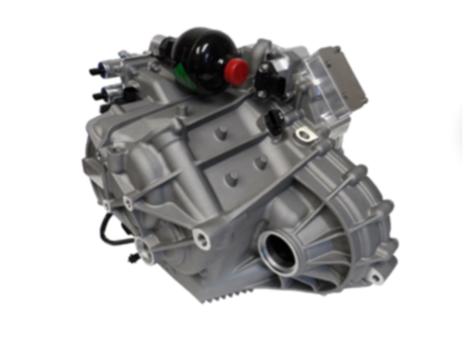Novel powershift arrangement combines seamless shift feel with reduced energy consumption
Specialist engineering consultancy, Drive System Design (DSD), is developing a highly efficient three-speed transmission for next-generation hybrid and electric vehicles (HEVs). Called MSYS, the system uses the powershift principle to overcome torque interruption during shifts, providing ultra smooth shifting. This allows HEVs to access the efficiency benefits of a multi-speed transmission while maintaining maximum comfort for vehicle occupants. A multi-speed transmission enables an EV or HEV to achieve higher performance or increased range by using its motor more efficiently than a single-speed arrangement, but often compromises driver and passenger comfort through the interruption of drive to the wheels during ratio changes, or by having large ratio steps. DSD’s new MSYS transmission provides EVs with a seamless shift feel by combining smaller than usual ratio steps with a low energy hydraulic shift, driving like an automatic but with much higher efficiency.
“Most transmissions have a step between ratios of 2.0:1 or more,” explained DSD’s technical director, Alex Tylee-Birdsall. “We identified that there is a threshold value of around 1.5:1, below which the shift event can be made to feel imperceptible to the driver and occupants through accurate control of the powershift actuators.”
Compared to a single-speed EV or HEV transmission, MSYS provides a 40 percent weight saving and 10-15 percent lower vehicle energy consumption, because it permits downsizing of the motor and, by being in the optimum gear ratio more often, extends the time the motor spends operating at high efficiency. It also allows motors to run at lower speeds that do not require high levels of field weakening that would increase energy consumption from the batteries.
“The reduced vehicle energy consumption can be taken as a 10-15 percent increase in range, or a saving of 10-15 percent in battery size,” said Tylee-Birdsall.
The MSYS powershift system is similar in operation to a dual clutch system but whereas a DCT shift requires continuous power, either to hold clutches open or closed, MSYS only draws power during the actual shift event. While most powershift solutions only provide smooth shifting during up-shifts with power applied, MSYS is unique in providing power shifting under all conditions. Although DSD still remains secretive about the system, it plans to disclose technical details later this year and is discussing the technology confidentially with a number of vehicle OEMs and Tier 1 suppliers. DSD has applied for several patents on the system.
“Though novel in application, the technology of the powershift system is well established and mechanically proven,” explained Tylee-Birdsall . “This means the development risk is low and component and system suppliers can make use of their existing expertise.”
MSYS provides a complete, high efficiency powertrain when combined with a suitable electric motor. The MSYS powertrain was co-funded by the Technology Strategy Board, the UK’s innovation agency, in a project led by DSD, with partners Jaguar Land Rover, YASA Motors and MIRA, the advanced vehicle engineering consultancy. The overall weight of the complete MSYS 3-speed powertrain, including motor and fluids, is just 45kg. The system produces an output torque to the wheels of over 2000Nm, even at low motor speeds, with a continuous power rating of 55kW and a peak of 100kW for 60 seconds. Overall system efficiency, including the power electronics, is 91 percent.
“MSYS enables an EV to be geared for 100mph for autobahn cruising, yet still satisfy gradeability requirements for hill-climbing and pull-away,” said Tylee-Birdsall . “In terms of legislative emissions targets for 2020, it can provide a 95g/km solution for CO2 emissions when applied to a typical PHEV.”
Currently in the prototype build stage, the MSYS transmission will be available in Q4 this year in a B-class demonstrator vehicle for customer evaluation.
Interest from the industry has been strong, with two European premium-segment OEMs in detail discussions and recent additional enquiries from three further OEMs. A development licensing agreement will shortly be announced with a Tier1 supplier. MSYS will be ready for series production during Q4 2016, in time to support the vehicle manufacturers’ need to comply with 2020 emissions regulations. Initial volumes, up to 50,000 per annum, will be supplied through DSD’s recently announced involvement in the Proving Factory. Higher volumes, predicted to reach 500,000 by 2020, will be licensed to existing Tier1 automotive transmission manufacturers.
A family of MSYS powertrains with different power and torque outputs is planned, to suit the requirements of different target sectors. DSD built its reputation working with a wide range of vehicle manufacturers, including 11 from Europe, 2 from the USA and 2 from China.
About DSD
DSD is an innovative engineering consultancy specialising in the design , development and control of transmission systems and the integration of driveline systems into vehicles. Founded in 2007, DSD has inherited decades of experience from its key personnel, each of whom are leaders in their individual fields of engineering, and currently employs over 30 staff with particular expertise in driveline refinement, efficiency improvement and hybrid and electric vehicle transmissions. The company won the prestigious “Consultancy of the Year” accolade in the 2010 British Engineering Excellence Awards.
 DSD’s MSYS 3-speed transmission produces an output torque to the wheels of over 2000Nm, even at low motor speeds, with a continuous power rating of 55kW and a peak of 100kW for 60 seconds
DSD’s MSYS 3-speed transmission produces an output torque to the wheels of over 2000Nm, even at low motor speeds, with a continuous power rating of 55kW and a peak of 100kW for 60 seconds

